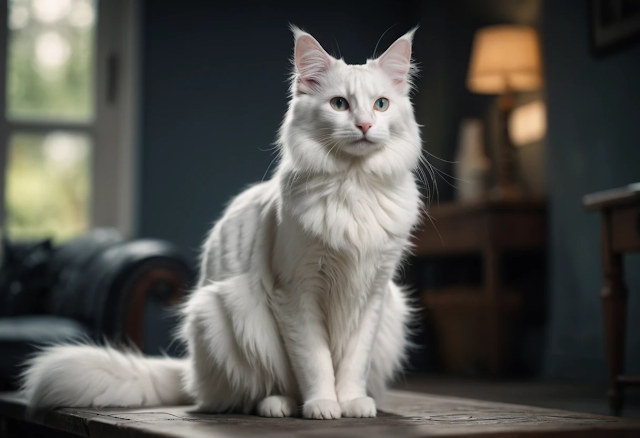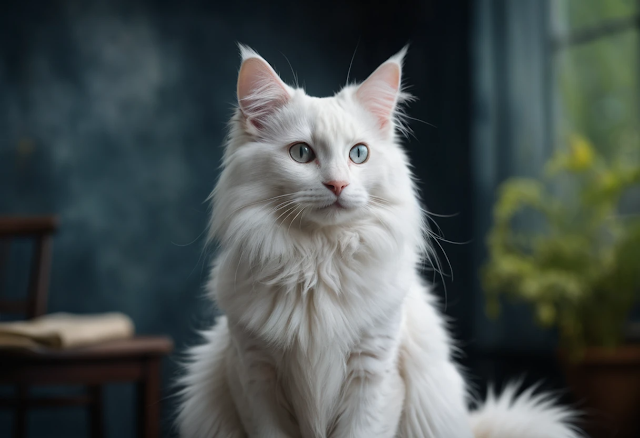Turkish Angora Cats: The Graceful and Playful White Beauties
The Turkish Angora, a breed celebrated for its silky white coat, elegant demeanor, and playful personality, has captivated cat lovers for centuries. Originating from Ankara (historically Angora), Turkey, this breed boasts a rich history and a distinctive appearance that sets it apart. This article delves into the fascinating world of Turkish Angora cats, exploring their origins, physical characteristics, temperament, care requirements, and health considerations, providing a comprehensive overview for anyone considering welcoming one of these graceful beauties into their home.
Origins and History
The Turkish Angora's history is deeply intertwined with the city of Ankara. These cats are believed to be one of the oldest natural breeds, with their ancestors roaming the mountainous regions of Turkey for centuries. They were highly prized by Turkish royalty and were often given as gifts to European nobles and dignitaries as early as the 16th century. This led to their introduction to Europe, where they played a significant role in the development of other longhaired breeds, including the Persian.
During the early 20th century, the Turkish Angora's popularity waned as the Persian gained prominence. However, a dedicated breeding program at the Ankara Zoo helped preserve the breed in its native land. In the 1960s, American cat fanciers became interested in the Turkish Angora, and efforts were made to import and establish the breed in North America. The Cat Fanciers' Association (CFA) officially recognized the Turkish Angora in 1973, solidifying its place as a distinct and cherished breed.
Physical Characteristics
The Turkish Angora is a medium-sized cat with a lithe and graceful build. They typically weigh between 5 and 9 pounds. Their most distinguishing feature is their long, silky coat, which is typically white but can also come in a variety of other colors and patterns, including black, tabby, and tortoiseshell. However, the pure white Angora remains the most iconic.
Other notable physical characteristics include:
Head: Small to medium-sized, with a wedge-shaped head and a long, tapering muzzle.
Eyes: Large, almond-shaped, and expressive. Eye color can vary, including blue, green, gold, amber, or odd-eyed (one blue and one of another color).
Ears: Large, pointed, and set high on the head.
Body: Long, slender, and muscular.
Tail: Long, tapering, and plume-like.
The Turkish Angora's coat is single-layered, meaning it lacks a dense undercoat. This makes them relatively low-shedding compared to other longhaired breeds.
Temperament and Personality
Turkish Angoras are known for their intelligence, playfulness, and affectionate nature. They are highly social cats that enjoy interacting with their human families and often form strong bonds with one particular person. They are also known to be quite vocal, often "talking" to their owners.
Key aspects of their temperament include:
Intelligence: They are quick learners and can be easily trained to perform tricks or follow commands.
Playfulness: They are active and energetic cats that enjoy playing with toys and exploring their surroundings. They often retain their kitten-like energy well into adulthood.
Affectionate: They are loving and devoted companions that enjoy cuddling and spending time with their owners.
Social: They generally get along well with other cats and even dogs, especially if introduced at a young age.
Curious: They are naturally curious and inquisitive, always eager to investigate new things.
Care Requirements
Caring for a Turkish Angora involves providing them with a balanced diet, regular grooming, and plenty of opportunities for play and exercise.
Diet: Feed them a high-quality cat food that is appropriate for their age and activity level.
Grooming: Their long, silky coat requires regular brushing to prevent mats and tangles. Brushing a few times a week is usually sufficient.
Exercise: Provide them with plenty of toys and opportunities for play to keep them physically and mentally stimulated. Cat trees, scratching posts, and interactive toys are all excellent choices.
Litter Box: Keep their litter box clean and accessible.
Veterinary Care: Regular veterinary checkups are essential to ensure their overall health and well-being.
Health Considerations
While generally a healthy breed, Turkish Angoras are prone to certain health conditions, including:
Hypertrophic Cardiomyopathy (HCM): A common heart condition in cats.
Ataxia: A neurological disorder that affects coordination and balance. This is more prevalent in kittens.
Deafness: White Turkish Angoras with blue eyes are more prone to deafness.
Responsible breeders screen their cats for these health conditions to minimize the risk of passing them on to their offspring.
The Turkish Angora is a truly remarkable breed that combines beauty, intelligence, and affection. Their elegant appearance, playful personality, and loving nature make them wonderful companions for individuals and families alike. While they require regular grooming and attention, the rewards of owning a Turkish Angora are immeasurable. If you are looking for a graceful and playful feline friend, the Turkish Angora may be the perfect breed for you. Their rich history and captivating charm ensure they will continue to be cherished by cat lovers for generations to come.
.jpg)









